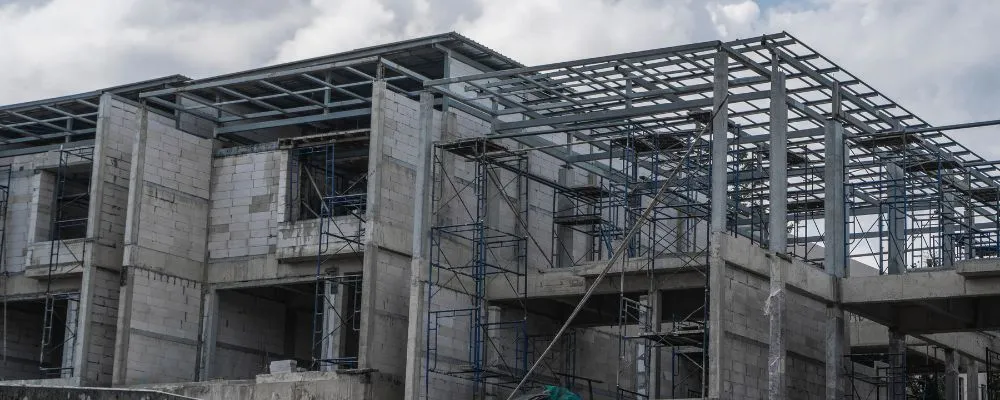Modern architecture and engineering are being changed by precast building construction. In this blog Brick & Bolt will explain about precast building construction, why it’s becoming more popular, the different types of precast building elements that are used, and the pros and cons of this method.
What is Precast Building Construction?
Precast building construction is the process of making structures out of concrete by pouring concrete into reusable moulds in a factory environment. Then, these precast concrete elements are brought to the building site and put together to make the structure that is needed. In standard building methods, concrete is poured and hardened on-site. This method is different. Precast construction is popular among builders and engineers because it is known for being precise, high-quality, and quick.
The first step is making a mould based on the specific design requirements. The concrete is then poured into the mould and protected while it sets. After the precast elements have hardened, they are brought to the building site and assembled together, usually with the help of cranes and other material-handling machines. This method ensures that the elements are made consistently and accurately, which lowers the chance of mistakes during construction.
Also read: Improving Construction Site Safety
Why Choose Precast Construction?
There are several reasons to choose precast construction methods instead of traditional ones:
1. Quality Control
Precast elements are manufactured in a controlled factory environment that allows strict quality control measures to occur. This results in elements that are of good quality, uniform, and meet certain standards.
2. Time Efficiency
Precast concrete parts can be made off-site in a controlled environmentmanner, which greatly reduces the time needed for construction on-site.
3. Cost-Effectiveness
Even though moulds and shipping costs are higher at first, the precast construction can save you money in the long run. Overall savings come from lower labour costs, less waste, and shorter building times. If you are not aware of construction costs, our cost estimator will help you to calculate your construction budget so that you can plan accordingly.
4. Strength and Durability
People know that precast concrete is strong and lasts a long time. Because the manufacturing environment is controlled, high-quality materials and precise mixing methods can be used. This makes the elements strong enough to survive a wide range of environmental conditions.
5. Versatility
Precast concrete can be used to build many different things, from homes to commercial buildings, bridges and infrastructure projects. Many industries choose it because it can be used in many situations.
Types of Precast Elements Used in Construction
Different types of elements are used in precast building construction, and each one has a specific purpose to do. People mostly use the following types of precast elements in their construction:
1. Precast Beams and Columns :
This type of precast element is strong and long-lasting, which makes it perfect for use in load-bearing walls or columns. Precast beams and columns are often used in commercial buildings, bridges, and buildings with multiple floors.
2. Precast Slabs
Precast slabs are used for floors and roofs. There are two types of precast slabs and they are solid slabs and hollow-core slabs.
3. Precast Walls
You can use precast walls as load-bearing or non-load-bearing parts. Some of them are solid walls, sandwich panels (which keep heat in), and architectural panels (which make a building look better).
Advantages and Disadvantages of Precast Building Construction
Precast building construction has a lot of advantages, but it also has some disadvantages. Let’s look at both sides:
Advantages of Precast Building Construction:
- The controlled factory environment ensures that the products are of high quality and meet all the requirements for size and shape. This improves the final product and reduces the number of changes that need to be built on-site.
- As mentioned above, precast elements can be made while the construction site preparation work is going on. This parallel work reduces the time it takes to build something so that projects can be finished faster compared with traditional construction methods.
- Most of the building work is done off-site, which means that a lot less work needs to be done on-site. This not only saves money but also reduces the chance of crashes and harm on the construction site.
- Precast construction produces less waste than traditional methods. The controlled manufacturing process allows precise material use, which cuts down on waste and helps make buildings more eco-friendly.
- Making precast elements in a factory reduces the amount of dangerous work that needs to be done on-site, making the building site safer and reducing accidents.
Disadvantages of Precast Building Construction
- Making moulds and setting up precast manufacturing can cost a lot at first, which could be a problem for smaller projects with limited funds.
- Even though precast construction is flexible, it may not be as easy to design as traditional methods. Using precast methods may make it harder and cost more to create complex or custom designs.
- When precast elements are used, there needs to be enough space on-site for storage and assembly. This can be difficult in cities with lots of people or on building sites with limited space.
In conclusion, if you know about precast building construction, then you can make smart choices about using this method for your projects. Even though there are some problems, the pros of precast construction make it a good choice for current construction needs. Precast building construction is going to become more and more important in shaping the future of architecture and engineering as the industry keeps coming up with new ideas. Build your home with the best construction company in Bangalore and experience the hassle free construction experience.
Also read : How Modular Building Methods Expedite Construction Timelines.

